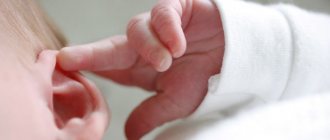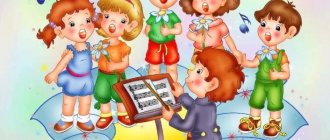Exercises to develop phonemic awareness
Phonemic (speech) hearing is the ability to catch and identify the sound (phonemes) of native speech, determine the semantic load of words, sentences, and texts.
This type of hearing allows you to distinguish the volume of a conversation, intonation, and voice timbre. They say that a child receives absolute pitch from birth. However, without supporting and developing it, “absoluteness” gradually fades away with age. To prevent this from happening, hearing must be fully developed.
An unborn child is capable of hearing a huge number of sounds. Among them are contractions of the mother’s heart, the sound of amniotic fluid, and external sounds. At birth, the baby is able to hear even things that an adult is unlikely to pay attention to. The peculiarity of an adult is to focus attention only on those sound options that he needs at a given time, while completely ignoring the rest. A newly born child does not yet know how to focus his attention and separate sounds into necessary and unnecessary. This is what he must learn.
Phonemic hearing helps to isolate individual sounds from ordinary noise. To begin with, the baby begins to identify the individual sounds that he hears most often: these are the voices of his parents, his own name. That is why often the first word spoken by a baby is the word he hears most often.
If in early childhood a child is surrounded by musical sounds, including lullabies that his mother sings to him, we can say that in the future the baby may develop an ear for music. Of course, such hearing also needs to be developed: listen to and analyze musical works together with the child, master the rhythms, which can be achieved by simple playful dancing with the child. The child must learn to distinguish good music from aggressive, playful from sad, etc.
What awaits a child if you do not pay attention to the development of his hearing? Let's give an example: a deaf-mute family has a baby who can both hear and speak. He does not hear conversation as often as necessary, does not understand its significance in the social world, he loses the ability to distinguish sounds, much less repeat them and use them for his own communication. As a rule, such children either do not know how to speak at all, or do not do it well enough.
For the same reasons, learning a foreign language is much easier when you are in an environment where everyone around you communicates in that language. Every person has a natural gift for imitation and capturing sound differences.
Exercises for the development of speech hearing must be carried out starting from the moment when the child begins to respond to sounds, first showing him the source of the sound, then explaining what and how made it possible to reproduce this sound. How can you determine whether your baby’s phonemic awareness is developing sufficiently? We will give you several activities that can be used both as a diagnostic of development and in developmental terms. When performing exercises, take into account the age of the child: a three-year-old child may not be able to cope with the last exercise, but if this happens at 6-7 years old, the development of his hearing must be urgently helped.
First, the child should be taught to separate speech among other sounds.
- What's the sound?
This lesson has three difficulty options:
- The sound of a rattle, bell or whistle?
- The sound of apartment keys, the sound of a spoon hitting a plate, or the leafing of a book?
- A box of matches, sand or pebbles?
- What's the weather like?
An activity in the form of a game, taking place during a walk on a fine day. The adult quietly shakes the rattle (good weather), then shakes it sharply, making a strong sound (it started to rain) and asks the baby to run up and supposedly take shelter from the imaginary rain. It is necessary to explain to the child that he must listen to the sounds of the rattle and, depending on the intensity of the sounds, “walk” or “hide.”
- Guess the action.
Several children are sitting on chairs. The hands are on the knees. The adult hits the drum hard, the children raise their hands up. If the blow is weak, there is no need to raise the handles.
- Guess the instrument.
An adult should introduce children to popular musical instruments. It could be a whistle, guitar, pipe, drum, piano. It is necessary to play the sound of each of them. Then the adult hides behind the partition and makes instrumental sounds, while the children must guess which instrument was sounded.
- Guess the direction of the sound.
The child closes his eyes, and at this time the adult blows the whistle. The baby must determine where the sound is coming from. Without opening his eyes, he should turn around and point in the direction with his pen.
Only when the baby learns to separate sounds can you move on to further exercises. Now it’s time to explain that the same sound can have different sounds:
- a-a-a - we show the doctor the neck;
- a-a-a - we lull the doll to sleep;
- a-a-a - something hurts;
- o-o-o – it’s hard for grandma to carry the bag;
- o-o-o – surprise;
- o-o-o - let's sing a song.
To begin with, the baby learns to repeat the sounds on his own, then tries to guess what the adult wants to say with this sound.
In order for the baby to easily navigate the variety of different sounds, an adult must tell how a particular sound is reproduced. To do this, it is necessary to demonstrate the importance of lips, tongue, teeth: it is better to use a mirror for this purpose. The baby learns to recognize and pronounce sounds, starting with vowels, gradually increasing complexity with the use of consonants.
After mastering such knowledge, it is necessary to begin developing auditory memory - the ability to compose words from sounds. Here it is important not only to hear the set of sounds in words, but also to remember their order. You should start with simple short words pronounced in the following order:
- boom-bom-boom;
- rock-rak-roar;
- so-tok-tok;
- hand-flour-pike;
- vine-goat-thunderstorm;
- jar-semolina-ranka.
You can invite your child, after listening to a number of words, to isolate the unnecessary from it (this is how a sense of rhyme is developed):
- mountain-hole-feather;
- laughter-snow-sun.
You can practice solving riddles, the answer to which should rhyme. For example: there is a belly and four ears on both sides, but what is her name? Pillow!
Imagine that you are at a children's competition and rooting for some team. We clap our hands and say with emphasis: well-done, let's-be-dim, ve-se-lei, do-go-nyay. In this way, you can teach your baby to divide words into syllables.
Such simple play activities will not only please your baby, but will also expand his phonemic awareness. Starting with simple exercises can prepare your child for more complex activities.
Read more on the topic of hearing loss
Raising children with hearing impairments
Hearing impairment in childhood is not uncommon. They can occur under the influence of external factors (illness and injury) and develop due to the baby’s genetic predisposition to hearing loss. If there are people in your family whose hearing has deteriorated over time, there is a chance that this will happen to your child. From an early age it is necessary to be observed by a pediatrician. If there are any deviations from the norm, the doctor will refer the little patient to a hearing specialist. Read more >>>
Hearing developmental disorders
According to the World Health Organization, every 20th person on earth has hearing problems. The ability to hear is an extremely important feature of a person, allowing him to freely navigate in space, as well as communicate with other people. However, not all people can fully perceive surrounding sounds and signals. Read more >>>
People with hearing loss
Through the organs of hearing, a person perceives most of the information in the surrounding world. Thanks to the ability to hear, people are able to freely communicate with each other, watch movies, listen to their favorite music, and simply feel comfortable on the street. Unfortunately, under certain negative influences of the external environment, this ability can be lost. Read more >>>
Features of hearing impairment
Hearing is one of the most important “windows” a person has into the world, allowing him to perceive sounds and signals from the environment. Some experts place the ability to hear in importance on par with vision, arguing that the inability to perceive sounds disorients a person in space to the same extent as when losing vision. The characteristics of hearing impairment are in most cases similar for each person, only the degree of complexity of the disease differs. Read more >>>
Exercises for developing musical ear
Support for the musical form of hearing is required for every person who loves and respects music or is engaged in active creativity. Let's understand the concepts of relative and absolute hearing.
Notes, in fact, are certain sound signals that differ in sound frequency. The presence of absolute pitch in a person makes it possible to separate the main tonality from multi-frequency reproduction without error.
The relative form of musical ear allows us to determine the comparative characteristics of notes and their relationship to each other. In simpler terms, in order to name the required note, such a person needs to hear another, preferably a nearby note.
A huge role in studying the musical development of children belongs to the famous Soviet teacher V.V. Kiryushin, who, instead of boring and obscure solfeggio classes, read to children a number of fairy tales he invented. The children not only listened with pleasure, but also remembered what was told, because there were so many interesting things in the fairy tales: the adventures of the kind animals-intervals, the teddy bear who raised the turnip, the struggle of dissonance and consonance, the septim dragons with seven heads and much more. Such fairy tales turned out to be extremely effective and allowed the child to master musical literacy with ease and pleasure.
It is possible to start classes according to the Kiryushin scheme almost from the first days of a child’s life. There is a lot of material on the Internet about the famous teacher’s system: collections of his fairy tales, musical works for children, classes on independent playing of musical instruments.
Ilana Vin’s educational system is also well received by children. Thus, her book “How the Notes Met” received positive assessments from many music teachers.
In home practice, you can use some simple exercises that subconsciously develop your hearing:
- When you walk the streets, listen to what passersby say. Short excerpts from phrases, fragments of words - all this will help you remember sounds in the future and be attentive to them.
- Try to remember the timbre of the voice of those people with whom you have to communicate. What is the point of this exercise? Each voice is individual, it has its own unique features and manner, intonation and pronunciation. This will allow you to identify and remember sound variations. Some people, having barely heard someone else's speech, can accurately determine where a person comes from, and even guess many of his personal qualities.
- A good effect is observed when guessing the speaker by voice. This is a kind of game, and even quite interesting.
- Try to identify your acquaintances and friends by the sound of their steps.
- Listen to a fragment of music and try to sing it from memory, hitting the notes as best as possible.
- And finally, memorizing songs: this develops musical memory. When memorizing a piece of music, repeat the failed section of the melody until you can repeat it without errors.
There are also many computer programs aimed at developing the musical form of hearing: these are “Musical Arcades”, “Ear Master Pro”, “Music Examiner”, “Ear Gryz”, etc. Such programs should not be considered as the main tool for self-development, but only only as an addition to general training.
Regarding the musical development of a child, it should be noted that often even the most capable children, from the point of view of teachers, are reluctant to agree to study music. In such cases, we can only advise one thing: never force your child to study by force (they say, when he grows up, he will say “thank you” himself). Try to interest the child, show him the most attractive and fun sides of such activities: the child should develop motivation and personal interest in music.






